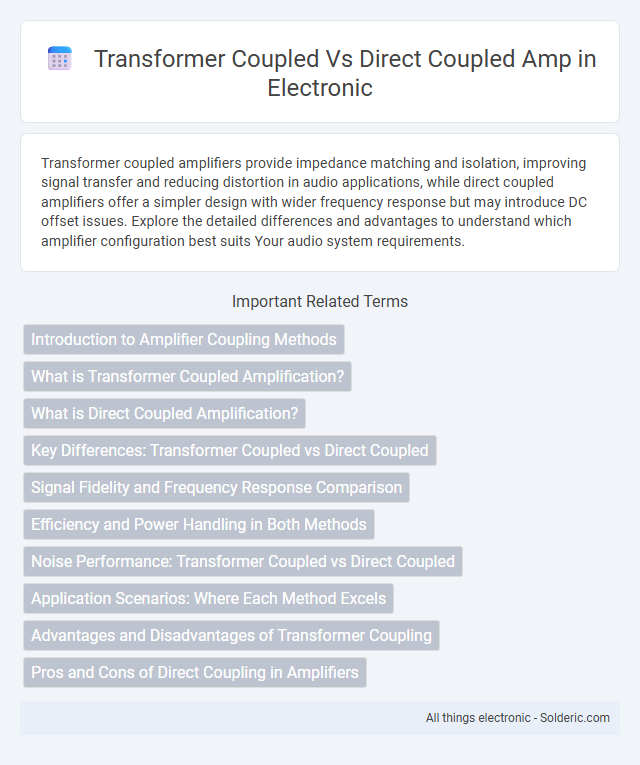Transformer coupled amplifiers provide impedance matching and isolation, improving signal transfer and reducing distortion in audio applications, while direct coupled amplifiers offer a simpler design with wider frequency response but may introduce DC offset issues. Explore the detailed differences and advantages to understand which amplifier configuration best suits Your audio system requirements.
Comparison Table
| Feature | Transformer Coupled Amplifier | Direct Coupled Amplifier |
|---|---|---|
| Coupling Type | Uses magnetic transformers to transfer signals | Direct electrical connection without transformers |
| Frequency Response | Limited; low-frequency roll-off due to transformer core | Wideband; suitable for DC to high frequencies |
| Size & Weight | Bulky and heavy due to transformers | Compact and lightweight |
| Cost | Generally more expensive due to transformers | Less expensive; fewer components required |
| Distortion | Transformer can introduce non-linear distortion | Lower distortion; better linearity |
| Application | Used in impedance matching and isolation | Preferred in DC amplifiers and wideband circuits |
| Power Efficiency | Lower due to transformer losses | Higher; minimal power loss over coupling |
Introduction to Amplifier Coupling Methods
Transformer coupled amplifiers use transformers to match impedance and provide electrical isolation between stages, enhancing signal transfer efficiency and reducing distortion in audio applications. Direct coupled amplifiers connect stages without transformers, enabling wider frequency response and faster transient response due to the absence of reactive components. Transformer coupling suits low-frequency or high-power scenarios, while direct coupling is preferred for wideband and low-distortion amplification.
What is Transformer Coupled Amplification?
Transformer coupled amplification utilizes a transformer to match impedance between the amplifier and the load, enabling efficient power transfer and voltage step-up or step-down. This coupling method isolates the input and output stages, reduces signal distortion, and improves frequency response by minimizing losses and facilitating proper impedance matching. Transformer coupled amps are preferred in audio and RF applications where impedance matching and signal integrity are critical.
What is Direct Coupled Amplification?
Direct coupled amplification refers to a design where the amplifier stages are connected without any intervening components like transformers or capacitors, allowing the signal to pass directly from one stage to the next. This configuration provides a wider frequency response and improved phase linearity compared to transformer coupled amps, which can introduce distortions due to magnetic coupling. Your audio system benefits from more accurate signal reproduction and better low-frequency performance with direct coupled amplification.
Key Differences: Transformer Coupled vs Direct Coupled
Transformer coupled amplifiers use a transformer to match impedance and provide voltage gain, enhancing signal strength and isolation, while direct coupled amplifiers connect stages directly without transformers, enabling wider bandwidth and improved linearity. Transformer coupled amps often exhibit higher distortion due to core losses and size constraints, whereas direct coupled designs offer better frequency response and stability, making them ideal for low-frequency or DC amplification. Your choice depends on the application's need for frequency range, signal integrity, and size considerations.
Signal Fidelity and Frequency Response Comparison
Transformer-coupled amplifiers exhibit enhanced signal fidelity by providing galvanic isolation and impedance matching, which minimizes distortion and preserves waveform integrity. Their frequency response, however, can be limited by the core material and winding inductance, resulting in reduced performance at very low or high frequencies compared to direct coupled amplifiers. Direct coupled amplifiers offer a wider and more linear frequency response with minimal phase shift, maintaining consistent signal fidelity across the audio spectrum without the bandwidth limitations of transformers.
Efficiency and Power Handling in Both Methods
Transformer-coupled amplifiers typically offer higher power handling capabilities due to impedance matching between the amplifier and load, resulting in efficient power transfer and reduced signal distortion. Direct-coupled amplifiers eliminate the need for heavy transformers, improving low-frequency response and allowing better control over DC conditions, but may face challenges in handling high power without thermal management. Your choice depends on balancing efficiency demands and power handling requirements, with transformer coupling preferred for high-power applications and direct coupling suited for precision and low-frequency stability.
Noise Performance: Transformer Coupled vs Direct Coupled
Transformer coupled amplifiers typically exhibit better noise performance due to isolation from DC offsets and reduced ground loop interference, resulting in cleaner signal transmission. Direct coupled amplifiers, while offering wider bandwidth and faster response, are more susceptible to noise from DC drift and power supply fluctuations. Careful design and component selection are critical in direct coupling to minimize noise compared to the inherent filtering advantage of transformer coupling.
Application Scenarios: Where Each Method Excels
Transformer coupled amplifiers excel in high-power audio applications and impedance matching scenarios, making them ideal for driving loudspeakers or transmitting signals over long distances with minimal loss. Direct coupled amplifiers perform best in low-frequency or DC amplification tasks, such as in instrumentation and precision analog circuits, where signal fidelity and wide bandwidth are critical. Your choice depends on whether you need robust power handling and isolation (transformer coupled) or precise signal amplification with minimal phase distortion (direct coupled).
Advantages and Disadvantages of Transformer Coupling
Transformer-coupled amplifiers provide impedance matching that maximizes power transfer and voltage gain, making them ideal for audio applications requiring high-fidelity signal transmission. However, their design complexity and size increase circuit cost and weight, while core losses and bandwidth limitations can reduce overall efficiency and frequency response. Unlike direct-coupled amplifiers, transformer coupling introduces phase shift and potential distortion, which may affect signal integrity in high-frequency applications.
Pros and Cons of Direct Coupling in Amplifiers
Direct coupled amplifiers offer improved frequency response and faster transient response compared to transformer coupled designs, making them ideal for audio and high-fidelity applications. However, they can suffer from DC offset issues and potential thermal drift, requiring careful bias stabilization to maintain signal integrity. Your choice depends on balancing the need for wide bandwidth and linearity against the complexities of managing DC conditions in the circuit.
transformer coupled vs direct coupled amp Infographic

 solderic.com
solderic.com